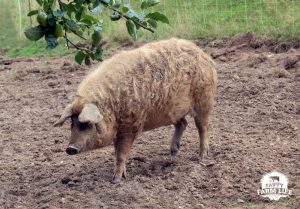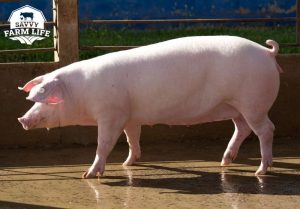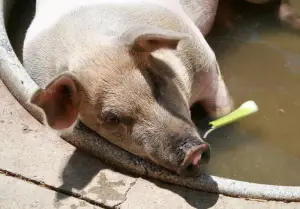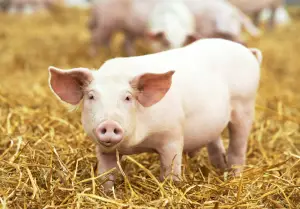Why Don’t Pigs Have Hair?
For most of us, the big pink farm hog will come to mind when thinking about pigs. These are the pigs most commonly portrayed in the media – take Babe, Wilbur, and Peppa as examples. These pigs usually appear to be smooth and hairless.
Why don’t these pigs have hair? All pigs do have hair, though some breeds have more than others. The variety of hair among breeds is the result of selective, intentional breeding. Pink pigs such as the Yorkshire, Landrace, and Chester White have sparse white hair over pink skin, giving them a smooth, bald appearance. Wild and feral pigs, on the other hand, usually have much hairier pelts.
Read on to learn more about the differences in pig hair among breeds, why some pigs have more hair than others, and how these animals fare in extreme weather.
Why Are There Differences In Hair Length Among Domesticated Pigs?
While the logical hypothesis when considering this question is that the hairier breeds originated in colder climates, that is not always true. Many of today’s most popular domesticated pig breeds originated in England and the United States, with two of the hairiest breeds – the Mangalitsa and the Kunekune – originating in Hungary and New Zealand, respectively.
While there are certainly some breeds that were bred for hair length according to their climate of origin, it is likely that most variation is simply for aesthetics. Wild boar, the ancestor of the domestic pig, are most often found in shades of black and brown. Many theorize that some of the most popular farm pigs today were bred to be pink simply out of novelty.
Modern domestic breeds come in a large variety of colors, including pink, brown, black, and cream. Some of these breeds are solid in color, and some are spotted or have other unique markings.
Ultimately, pig hair really isn’t all that important to farmers. Pigs have one main commodity, and that is their meat. While there is a business in sheep, alpaca, and even goat hair, pigs are bred for meat, and their hair is not a factor in productivity. So while the hair quality of a domestic pig is caused by intentional breeding, the result is not usually a primary factor that is specifically sought out.
Curly-Haired Pigs 
Did you know that there is a breed of pig known for its curly, wooly hair? This breed is called a Mangalitsa, and its coat resembles that of a sheep. Interestingly, the Mangalitsa does not require any additional grooming care – unlike other wool-producing livestock, Mangalistas do not need to be shorn each year. These pigs shed their hair in warmer climates, like all other “hairy” pig breeds.
In fact, Mangalistas raised in warmer climates do not carry as much fleece as pigs of this breed raised in colder climates. Because of the Mangalista’s unique hair, they are quite adaptable to cold weather. As you will learn below, pigs are not the most cold-hardy of livestock, making the Mangalista an excellent choice for pig farmers in colder climates.
Wild Pigs Have Longer, Thicker Hair
Wild boar, unlike most domestic farm pigs, do not have the luxury of a man-made shelter. They are subject to the local climate and have evolved to produce adequate hair to insulate them against both the cold and the heat. Most wild boars have a coarse, wiry overcoat with a softer, downy undercoat.
In addition to having thicker hair, many male wild boars have a strip of longer hair, or a “mane”, that runs down their neck and back. This mane will stand erect when the boar is startled or senses danger – likely acting as a means of defense against predators. When this hair stands up, it causes the animal to appear larger and more intimidating to its attackers.
Why Are There No Pink Pigs In The Wild? 
One of the reasons that pigs appear to be smooth or bald is because the white hair that covers a pink pig’s body can appear invisible against the pig’s skin. You won’t find this among wild pigs, as there are no “pink” wild boars.
Wild boar are usually found in various shades and patterns of black and brown. This is to help camouflage them – after all, a bright pink pig will find it difficult to sneak up on prey. Likewise, that same bright pink pig will act as a beacon to larger predators. Pink pigs would not make successful wild boars.
Will A Domesticated Pig Grow Longer Hair After Becoming Feral?
If you conduct an Internet search on the hair of feral pigs, you will find claims that a domestic pig, having gone feral, will grow a pelt similar to that of a wild boar within a matter of months. While this is a prominent claim, there does not seem to be much evidence to back this up.
Some believe that a domesticated pig will grow longer hair once feral due to its genetic makeup allowing for physical changes when exposed to environmental changes. Some believe that the once-tame pigs simply evolve into feral pigs with longer hair. This latter claim is reasonable, as pigs are known to breed prolifically, and you would be able to spot generational changes in a relatively short period of time.
Either way, this is a claim that is difficult to prove because a feral pig will quickly lose its tameness and will be difficult to follow, capture, and study once released into the wild.
How A Pig’s Hair Affects Heat Tolerance 
Assuming you are looking at pig breeds with equally sparse hair, you might consider raising a darker or spotted breed if you live in a particularly hot climate. Pink pigs lack the increased melanin that the darker breeds possess, and this, coupled with the sparse hair, makes them highly susceptible to sunburn.
If you do raise lighter pigs, know that you will need to offer them protection from the sun during the warmer months. It is not exactly feasible to cover a pig in sunscreen, so the only recourse you have in the Summer months will be offering unlimited access to shade. This shade may be in the form of a grove of trees but is more commonly a shed or other type of strong shelter.
How A Pig’s Hair Affects Cold Tolerance
Pigs do have a thick layer of fat that helps insulate them from the cold (this is where you get bacon). But because of their sparse coats, pigs are not as cold-tolerant as most other livestock. In fact, a 200 lb finishing pig can experience some degree of cold stress at just 50-60 degrees Fahrenheit – this temperature will be higher for younger and smaller pigs. At these temperatures, pigs will shift from using feed for growth and fat to using feed to stay warm. Even at these seemingly mild temperatures, a large pig farmer’s economics can be affected.
Keeping Your Pig Warm
Most of us live in regions where the Winter temperatures will fall to (or below) 50 degrees Fahrenheit. During these colder months, there are steps you can take to keep your pigs comfortable.
Make sure that your pigs have adequate shelter. You will want to provide insulation – this can be in the form of bedding or in insulated building materials. If insulating with bedding, make sure the pigs are living in ample bedding that is dry, not damp – dampness can leach the warmth from the pig’s body and leave them colder than if they were exposed to no bedding at all.
Most farmers use plenty of clean wood shavings or straw. Both work well as insulating agents, so long as you use enough. There is an added benefit to using a higher amount of bedding – it will help to keep the shelter clean and limit the odor produced by pig waste.
You will also want to ensure that your pigs are getting enough to eat. As stated earlier, when a pig is cold, it will require additional feed simply to keep warm. If you use the same amount of feed that you would in the warmer months, you may find your pigs growing more slowly than during other seasons.
Don’t underestimate wind chill. A pig may be able to tolerate a cooler temperature but may suffer if exposed to a draft. Try to limit the draft if possible, either by using shelters or vegetation.
Lastly, if you are breeding, invest in a heat lamp or two. Young piglets are particularly susceptible to cold stress and can suffer at temperatures as high as 85 degrees Fahrenheit. Use heat lamps during farrowing and as needed, according to the outside temperature.
In Conclusion, Pigs Do Have Hair
While pigs may appear smooth and bald, they aren’t. Pigs have hair, just like their wild ancestors, though to a lesser degree. The reason we think of pigs as “bald” is because most farm pigs have sparse white hair which appears almost invisible against the pig’s pink skin.

